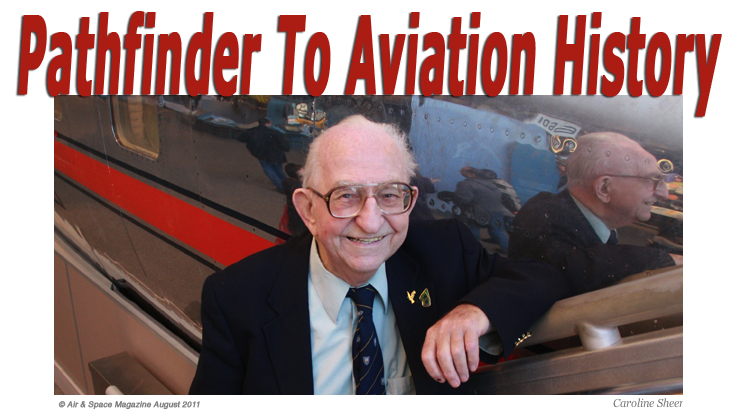
Ron Davies, Curator
of the Air Transport National Air & Space Museum, is pictured
here in Air & Space Magazine, August 2011. Davies died in
England on Saturday night at age 90.
His legacy to aviation, captured
in 25 books and other social efforts, are as pioneering and important
in scope as many of the subjects he wrote about including Lindbergh,
Earhart, Berlin Airlift and almost every major airline in the
world, past and present. |
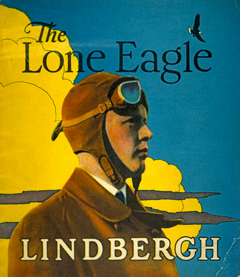 I
have been sitting and looking at a picture of Charles Lindbergh, a picture
that once served as the cover to a book he wrote about that first solo
Atlantic flight between New York and Paris in 1927. I
have been sitting and looking at a picture of Charles Lindbergh, a picture
that once served as the cover to a book he wrote about that first solo
Atlantic flight between New York and Paris in 1927.
My good friend and colleague for the past
thirty plus years, the great Ronald Edward George (REG) Davies (Ron),
died on Saturday, July 30, 2011 in Shaftesbury, England.
He was 90-years old.
Ron retired in February and returned to
Shaftesbury after 30 years as Curator of Air Transport at the National
Air and Space Museum in Washington, DC.
He leaves behind his wife, Marjorie, two
daughters, Jackie and Annette and two grandsons.
I first met Ron whilst researching my
book on the history of Newark Airport. At that time, he sat in the Lindbergh
Chair at NASM.
Ron was the inside guy with all the historic
information and I was an airport air cargo type who loved the history
of all of it. We hit it off at once.
After that first encounter, every time
I saw him it was the same thing – we would talk for hours about
all manner of aviation history, unaware of anything or anyone else in
the room, so intense were those conversations.
For us, Time truly stood still. Perhaps
it did so as a favor, for it was in those moments that we could further
examine history and pick its pockets of all the information collected
as it snowballed through the years.
H.G. Wells was spot-on when he wrote that
“there is no difference between Time and any of the three
dimensions of Space except that our consciousness moves along it.”
Ron was like a time machine whose trip
was always airborne, aviation bound.
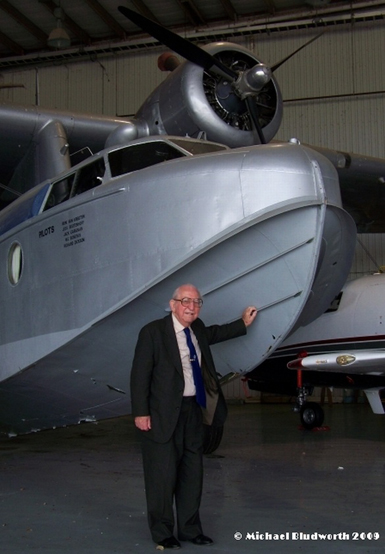 The
last talking session we had was inside his apartment in McLean, Virginia;
his good friend Chris Sterling and my wife Sabiha were also present. The
last talking session we had was inside his apartment in McLean, Virginia;
his good friend Chris Sterling and my wife Sabiha were also present.
All through that day, from our luncheon
right into cocktail hour, which included some crisps and a couple of
cans of British lager from the Davies' fridge, both Chris & Sabiha
were sidelined, the unwitting victims of Ron and my ability to prattle
on about aviation.
Ron was packing his boxes to return to
the UK to care for his ailing wife, Marjorie.
I had the feeling that leaving NASM was
the last thing he wanted to do, as he was still quite robust and totally
engaged in putting the finishing touches on his 25th book for Smithsonian.
But his love and devotion for his bride
of 63 years held sway.
“Marjorie was my love throughout
every experience of my life.
“It’s time to get home and
look after her,” he said quietly.
It was during that conversation that he
gave me an entire personal collection of his most favorite books, some
450 in all.
Ron’s last words to me were naturally
about what he thought was going to happen in future commercial transport.
“The wide-body ‘jumbo’
jets were twice as big as the Boeing 707 and Douglas DC-8.
“The same general principal still
applies, even though the 500-seat A380 is only half as big again as
the Boeing 747. The Boeing 787 will be a good replacement for the Boeing
767 or the Airbus A330, and good for domestic routes, but it will not
be a major element globally.
“Statistics show that 75 percent
of the world’s international traffic is served by only 25 major
airports.
“The A380 will meet the traffic
demand for this 75 percent, and it has no competitor in the same class.
Five airlines are currently operating more than 40 A380s, and this will
rise to close to 100 by the end of 2012.
“The 787 Dreamliner will be left to cope
with the remaining 25 percent.
“Today, airliners remain in service
for 30 years or more. The A380 will reach the half life point at around
the year 2020.
“Already, a French airline has ordered
two 820-seat all-economy A380s.
“There is also talk of a stretched
A380,” Ron Davies said.
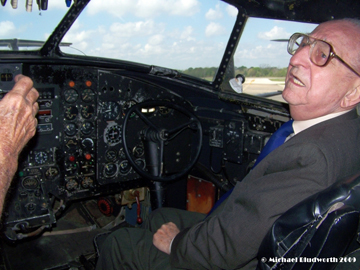 Recently,
Ron spoke to Air & Space Magazine about his career: Recently,
Ron spoke to Air & Space Magazine about his career:
“I have been able to visit all seven
continents, including Antarctica, fly around the world, and cross the
Seven Seas many times.
“Through airline contacts I interviewed
pioneers and leaders of the airline industry worldwide.
“I sank many a beer with chairmen
of the U.S. local service industry, sipped cappuccinos with the great
Ruben Berta in Brazil, and—possibly my most treasured memory—was
invited to take tea with India’s legendary J.R.D. Tata in his
suite at the Ashoka Hotel in Delhi in the early 1970s.”
REG Davies was educated at Shaftesbury
Grammar School. He started work in London in 1938 and was in the British
Army as a territorial volunteer from 1939 to 1946.
He spent a year in Iceland, training for
mountain and Arctic warfare, and drove his machine-gun carrier on to
the beaches of Normandy in 1944.
After WWII, Ron worked for the Ministry
of Civil Aviation, British European Airways, the Bristol Aeroplane Company
and de Havilland before moving to the United States in 1968 to lead
market research for Douglas Aircraft.
In 1981 he joined the National Air and
Space Museum as the Charles A. Lindbergh Chair in Aerospace History.
Davies was a member of three British Royal
Societies, the Explorers Club, and others in France and Brazil.
He also delivered the Wings Club Thirty
Seventh “Sight Lecture” (Hindsight, Insight, Foresight)
in 2000.
Worth noting is that past Sight Lectures
had been presented by Igor Sikorsky, Werner Von Braun, Grover Loening,
CR Smith, Juan Trippe, Richard Jackson, Neil Armstrong, Al Ueltschi,
Sanford McDonnell—the list goes on.
His last book, Airlines of the Jet
Age (for the Smithsonian Institution Scholarly Press), has just
been published (July 2011).
His friend, Christopher H. Sterling, Associate
Dean for Special Projects Columbian College of Arts and Sciences, George
Washington University remembers:
“I had the great pleasure of being
a friend of Ron Davies for most of the three decades he lived and worked
in Washington.
“To know the doyen of world air
transport history was both a treat and an honor for me, as few are lucky
enough to learn from a true giant (though I can feel his red pen poised
to edit these very words).
“He played a big part in our family’s
life, especially of our elder daughter who helped him produce many of
his books.
“I have especially warm memories
of afternoon tea, biscuits and good conversation over the years (and
not all of it about airplanes!).
“His productivity was a model for
all of us who write—as was his good cheer and quick wit, perseverance,
and his willingness to help and mentor others over the years.
“For what Ron accomplished in his
long life was and remains huge--vastly more than most ever achieve.
“From his research and travels over
more than six decades, he developed a uniquely important record of the
world’s airlines.
“And because Ron recorded much of
what he learned in his 25 books published since 1964 (the last appearing
only days before he died), true appreciation of all that he accomplished
will last around the world for a very long time . . . as will the degree
to which we deeply miss the man behind those books.”
Ron’s longtime friend, legendary
airline buff and fellow member of The Washington Airline Society, Daniel
Kusrow, recalled:
“I knew Ron for over 16 years.
“I first met him through the Washington
Airline Society.
“He was always very gracious and
encouraging in my air transport history researches.
“His office at NASM was like a mini
museum for airlines.
“On one entire wall were all his
individual airline research binders, another wall held file drawers
filled with filed vintage airline timetables, his primary source material.
“Each airline got a binder with
meticulous hand written notes, hand drawn maps and charts and diagrams.
“Plus there were letters Ron had
written to the executives of the airlines and their replies.
“It seemed like every airline executive
or CEO had time to write a reply to Ron; these people respected him
and their doors were always open to him.
“He loved jazz and actually ghost
wrote a book on its history, which was published in the UK in the early
1950s.
“I recently picked up a copy of
it, just a little paperback thing.
“As soon as I opened it, I saw Ron’s
Maps and timelines for the history of Jazz – classic Ron.
“We would all become quite familiar
with this format in his later 25 books on commercial air transport history.
“The last time I saw Ron Davies
was the evening of March 30th, 2011, at the National Air and Space Museum.
“I had taken his beloved Acela Express
(train) down from New York, and due to power issues at the Museum, we
were forced to hold the final part of our meeting of the Washington
Airline Society in the main Milestones of Flight Gallery.
“We were all standing in a circle
around Ron, and he was going on about the hard sell it was for Douglas
of the DC-10 to JAT of Yugoslavia in the early 1970s, and how he had
to ride the Orient Express out there to help close the deal.”
Recently, REG Davies, the great air transport
curator, had been talking about the railroads.
Ron loved rail and in the 21st Century
saw great promise in the tracks, especially in USA.
We have his story “High Speed Rail
Air Transports 21st Century Competitor” and will publish it here
in September, along with a video we created in McLean.
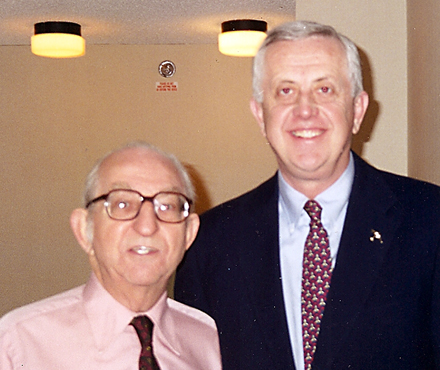 Once
upon a time, Ron & I (pictured in April 1997) cooked up
an idea to write some small, inexpensive books together. Once
upon a time, Ron & I (pictured in April 1997) cooked up
an idea to write some small, inexpensive books together.
It was right after we did “International
Airports”- a television documentary that is still being aired
on The History Channel.
He would write the text and draw the maps
and I would research and select all the pictures.
“We will draw on our strengths and
create some books that the children of the next generation will notice,”
Ron said.
Well, Ron went on to create several books
with artist Mike Machat about the airlines - Lufthansa, Delta and lots
of others.
I did my airport books and a couple of
inexpensive high volume efforts for KLM, American and Miami air cargo.
Creatively, I guess we traveled in parallel,
like two aircraft gliding over the darkened Atlantic, passing the familiar
in different cities.
Ron Davies was the greatest and most
prolific aviation historian that ever lived.
His work is impeccable, full of thorough
research and beautiful presentation.
His writings are colorful and rich in
detail and humor.
You can compare his books and years of
service in terms of content to the way Joe DiMaggio played baseball,
Winston Churchill gave a speech or Elvis sang a song.
Ron’s 1964 book A History of
the World’s Airlines is simply the best on the subject; in
importance and as a touchstone for the industry, it mirrors the likes
of Darwin’s On the Origin of Species.
It is a cornerstone of any aviation library
and such a work of art that it gives me the chills just to think about
it.
The book is still in print, so if you
don’t have it, get a copy, and if you don’t agree with my
rave, mail it to me and I’ll buy it from you.
I wrote to Ron a couple of weeks ago and
had hoped to hear back.
Ron was a snail mail contact, so I’ll
be watching for the postman while remembering this wonderful, sweet
guy.
The Lindbergh book cover is still staring
out at me.
Ron as a chronicler, conservationist,
author and historian was self taught and made, just like almost all
of those early pioneer pilots.
He leaves behind an immense body of work
that is expert, yet accessible, expansive, yet exquisitely detailed.
We will not see his kind again.
Happy landings, Ron.
Geoffrey
|


![]() 100%
Green
100%
Green